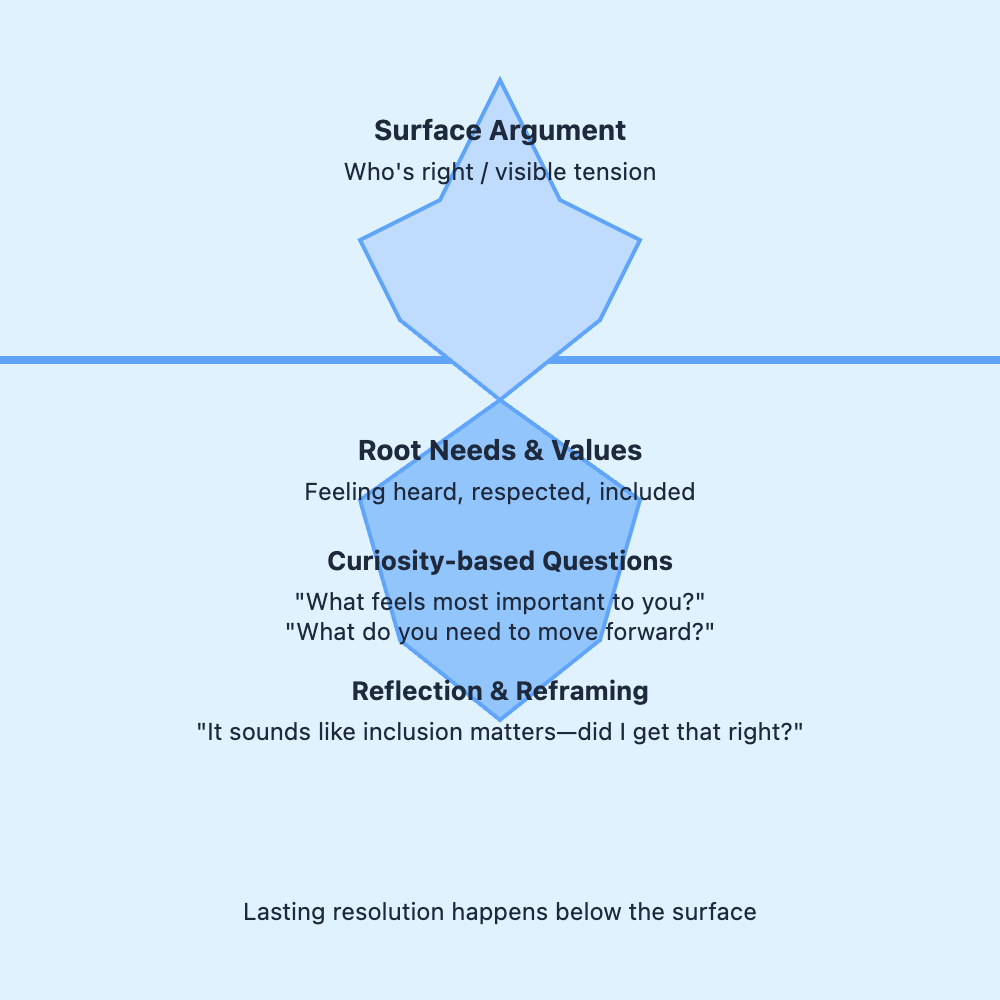When you’re called to mediate a conflict, it’s easy to get caught up in the details of the argument—who said what, or which deadline was missed. However, the real work of a skilled mediator is to look beneath the surface and help others discover what’s truly fueling the tension.
A helpful way to visualize this is to picture conflict resolution as an iceberg. The visible argument above the waterline is just a small part of the whole picture. Beneath the surface—like the larger, hidden part of an iceberg—are the core needs, values, emotions, or misunderstandings that often drive workplace conflict. In this unit, you’ll learn how to guide teammates past blame and debate, and toward these deeper root causes.

Most workplace arguments are about more than just the topic at hand. For example, a heated debate about project timelines might actually be about feeling excluded from decisions, not about the dates themselves. When people repeat phrases like "No one ever listens to my ideas", it’s a signal that the root issue could be a need for respect or inclusion, rather than a disagreement about a single meeting or deliverable. Emotional triggers, repeated complaints, or even what’s left unsaid can all point to deeper issues.
Misinterpretations are another common source of conflict. If someone says, "I thought you were ignoring my emails", the real problem may be unclear communication norms, not personal disrespect. As a mediator, your ability to notice these patterns and gently probe for more context is essential.
Here’s a realistic example of how a mediator can help uncover what’s really driving a conflict:
- Chris: I don’t get why we have to change the project plan again. It feels like my work keeps getting tossed aside.
- Jake: That’s not what’s happening, Chris. We just need to adjust based on new feedback.
- Chris: But every time there’s a change, I’m the last to know. It’s like my input doesn’t matter.
- Jake: I didn’t realize you felt that way. What’s most important to you about how we handle these changes?
- Chris: I just want to be included in the decisions, not find out after the fact.
In this exchange, Jake moves the conversation away from debating the project plan and instead asks Chris what matters most. This helps Chris articulate a deeper need for inclusion, not just a frustration about the plan itself.
Notice how the shift from defending actions to exploring needs opens up a more productive dialogue. As a mediator, your goal is to help both parties see and address these underlying issues—the part of the iceberg that’s hidden beneath the surface.
To help others move beyond surface arguments, use open-ended, curiosity-driven questions. Instead of focusing on who’s right, invite teammates to reflect on what matters most to them. For instance, you might ask, "What feels most important to you in this situation?" or "Can you share what you need in order to feel good about moving forward?" These questions encourage people to articulate their underlying needs and values.
When you sense a root issue, reflect it back to the group for clarity. For example, saying "It sounds like being included in decisions is really important to you—did I get that right?" helps everyone see the real source of tension and opens the door to more productive problem-solving. This approach shifts the conversation from blame to understanding, making it much easier to find lasting solutions.
By consistently guiding conversations below the surface—just like exploring the hidden part of the iceberg—you’ll help your team resolve not just the argument at hand, but also prevent similar conflicts from arising in the future. In the upcoming role-play session, you’ll get to practice these techniques—spotting root issues, asking clarifying questions, and reframing the conversation—so you can confidently mediate even the most stubborn workplace disagreements.
